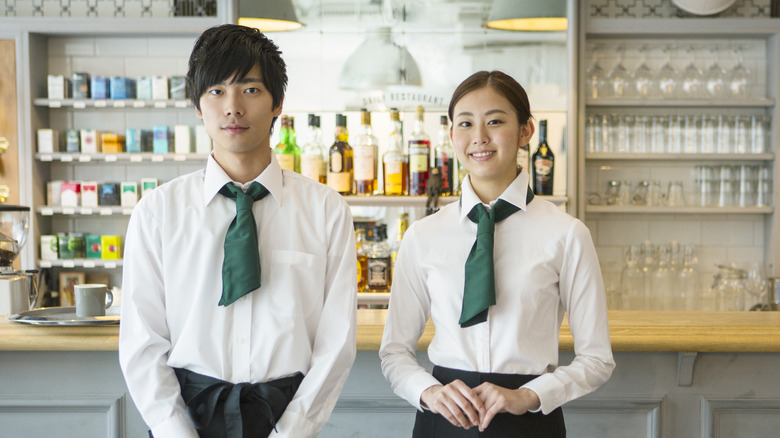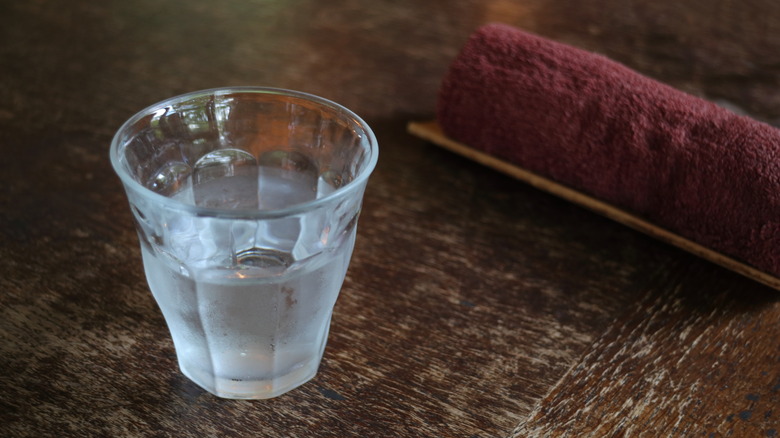The Best Way To Order Food At A Restaurant In Japan Is Often Seen As Rude In America
When you sit down for a meal at a restaurant in Japan, don't expect a server to come check whether you're ready to order. You can try to flag one down politely, but in some cases, the best way to get their attention is just to shout, "Sumimasen," which simply means, "Excuse me," in Japanese. This may go against every fiber of your being for Americans, since it would often be considered rude to shout for a server in the United States. Food Republic recommends signals like putting your menu down, raising your hand, making eye contact, or even calling your server by name as they pass by — anything but shouting.
In Japan, however, a subdued yell of "Sumimasen" is an accepted part of the dining culture in some restaurants, mostly traditional ones without automated technology. It depends on where you are, since many modern izakaya (Japanese gastropubs) and family restaurant chains now have call buttons on the table you can push. Before you go yelling, you should first look to see if your table has one of these buttons, which will give off a chime, alerting the wait staff that your table number needs service.
Other restaurants in Japan have tablets where you can input your order directly without needing to give it to a server. When there's not an English-language option, you can use this iPhone hack to translate the menu. If you're fortunate, you'll find a button or tablet on your table, allowing you to bypass the social awkwardness of shouting, "Sumimasen!" Otherwise, your best bet for catching your server's notice and placing an order is to be assertive and raise your voice.
You can modulate your voice when yelling 'Sumimasen'
@twosolesabroad THE WAY WE WERE SO CONFUSED HAHAHA 🤣 Calling a waiter in Japan for the first time was hilarious! In Japan, you have to raise your hand and yell "sumimasen" (which means "excuse me"). It felt so weird at first, but it's not rude at all here. We finally did it, and to be honest we were never so hyped to order food haha 😂 💡 TIPS for calling a waiter in Japan: • Raise your hand confidently and say "sumimasen" loud enough to get their attention • It might feel weird at first, but it's a normal practice in Japan • "Sumimasen" means "excuse me" and is the polite way to call for service If you're traveling to Japan, this is one of those unique experiences to try haha. It's a fun part of exploring things to do in Tokyo, Japan. These Japan travel tips are super helpful, especially if you're planning a Japan vacation soon! And if you're on a solo travel Japan adventure, these practical travel ideas will make your trip even better! #tokyo #japan #japantraveltips #japantips #japanfood #traveltiktok #travelcouple #vlog
Having worked as a restaurant server in high school and college, I personally underwent some culture shock with the dining culture when I uprooted to Japan in 2010. Even today in Tokyo, I can't bring myself to call for a server too loudly if they're all the way over on the other side of the restaurant. After all, this person is a server, not a servant. Even pushing a button to summon them, let alone shouting across the room, seems marginally rude. It's as if you were ringing a bell for your butler, expecting Jeeves to be at your beck and call every minute of every meal. That's probably best left for Japan's novelty butler cafes (Swallowtail in Tokyo being one).
The "Sumimasen" custom has been known to flummox traveling TikTokers, too, as you can see in the video above from @twosolesabroad. They banter about "how many decibels" you should yell, but they're sitting in what looks like an empty restaurant. The volume of your voice may depend on how busy and noisy the restaurant is. In some cases, you may need to really belt out "Sumimasen" to be heard. Doing so when no one else is around could be overbearing, so just use your best judgment and modulate your voice.
You'll notice in the video that they're not even sure, at first, who their server is and whether the person they were calling heard them. Eventually, that busy staff member comes walking over once their hands are free. This hints at another cultural difference between restaurants in the U.S. and Japan.
You may not have one assigned server
In the U.S., most restaurant servers are paid an hourly rate below minimum wage, with the understanding that the gratuities they receive will make up for that. Since they're reliant on tips, servers therefore have a vested interest in establishing a rapport with you and giving you good service. It doesn't always play out like that, of course, but that's the ideal. Things are very different in Japan, where the spirit of hospitality (omotenashi) is already embedded deep in the culture, and there's generally no tipping custom.
Some upscale or Western-style restaurants may put you with one server and add a service charge to your bill, while an izakaya might hit you with a seating charge, offset by a complimentary hors d'oeuvre. Either way, servers won't usually introduce themselves to you by name and be jonesing for a good tip throughout the meal. The service is less personalized, more of a team effort, which means you don't necessarily need to wait till you see the server who seated you to say, "Sumimasen!"
One server might take your order, and another might bring your food out, so that you're never even waited on by the same person twice. This isn't so different from U.S. restaurants that utilize hosts, servers, and food runners, except your server there would usually be your main point of contact, looking in on you more. In Japan, they'll often hang back so as not to bother you, attending to your needs only as you make them known. They might not even approach your table until you communicate that you're ready, pushing the call button or saying the magic word, "Sumimasen!"
You might need to speak up even just for water
When you dine out in the U.S., you may be accustomed to having a tall glass of water set down in front of you, first thing. At restaurants in Japan, don't be surprised to receive what seems like a half-empty thimble of water by comparison. People here tend to drink tea more than water. The water you do get, at least, is free, which isn't always a given internationally, as European travelers might know from paying for water in Spain.
You could get lucky and find a water pitcher on the table at some Japanese restaurants, like curry or ramen shops. With other restaurants, if you keep saying "Sumimasen" and asking for more "omizu" (water) or "ohiya" (cold water), your server might take a hint and bring you a bigger glass or carafe. Or they might just swoop in when they see you're getting low, like a server would stateside.
A good server in the U.S. will anticipate a guest's needs, keeping an eye on them and offering to refill their water before they even have to ask. I worked at multiple restaurants where we were also trained to hold plates back under a food warmer in the kitchen until all the orders for one table were ready. In Japan, by contrast, they'll sometimes bring your plates one at a time, serving one or more people ahead of others at the table. Just remember that what might seem like bad service could be a cultural difference. Another example of that: In place of napkins, you might be given a wet towel at restaurants in Japan.


